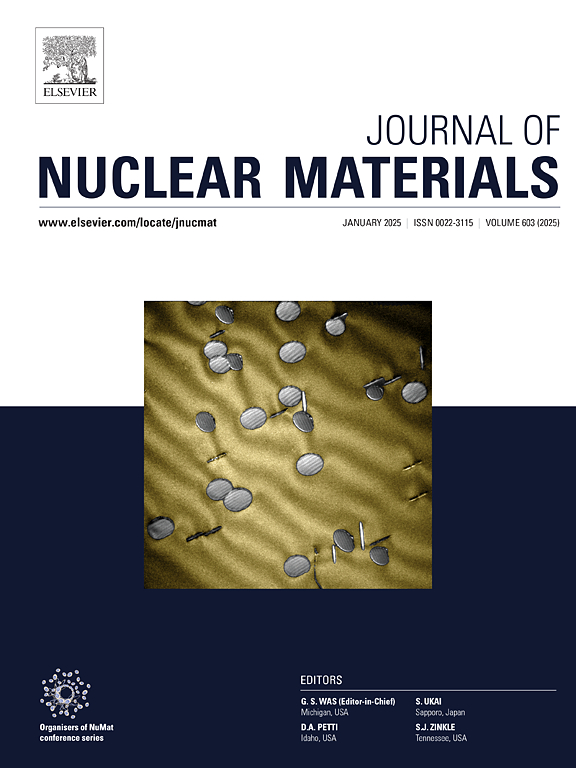Effect of gamma radiation on early age strength and pore structure development of metakaolin-based geopolymer used for conditioning cesium and strontium radioactive waste
IF 2.8
2区 工程技术
Q3 MATERIALS SCIENCE, MULTIDISCIPLINARY
引用次数: 0
Abstract
This paper presents the effect of gamma radiation on early age strength and pore structure development in metakaolin (MK)-based geopolymers containing realistic cesium and strontium loading determined based on Boom Clay, a hypothetical host formation under consideration in the Belgian geological disposal concept. The effect of gamma-induced heat was decoupled from the ionizing nature of gamma radiation and assessed separately to elucidate its impact on strength and microstructure development. Changes in pore structure were evaluated using nitrogen physisorption and mercury intrusion porosimetry. The results indicate that both gamma radiation and temperature, analogous to irradiation-induced heat, negatively impacted the strength and pore structure development. Gamma radiation exposure of fresh geopolymer samples resulted in a coarser microstructure, leading to lower strength. No dose rate effect was observed, but the type of gamma radiation source had a significant impact, particularly on pore structure. Geopolymer samples exposed to Cs-137 from spent nuclear fuel exhibited larger pore structure alteration than those exposed to Co-60 at the same cumulative dose and similar dose rates. This suggests that a higher degree of pore structure alteration than previously reported in the literature could be anticipated in real-world Cs and Sr immobilization. The pore structure alteration is attributed to both gamma-induced heat and gamma-assisted water radiolysis and subsequent H2 evolution and escape, with water radiolysis being the dominant mechanism of microstructural damage. Nevertheless, the MK-based geopolymer exposed to gamma radiation during hardening maintained satisfactory compressive strength, demonstrating strong radiation resistance. This indicates that MK-based geopolymer is promising for the immobilization of Cs and Sr-containing wastes. This study not only provides insights on formulating waste forms with realistic waste content in line with the foreseen geological disposal concept, but also advances our knowledge on mechanical and pore structure development under gamma irradiation, which have positive implications on radioactive waste management.
γ辐射对处理铯、锶放射性废物用偏高岭土基聚合物早期强度和孔隙结构发育的影响
本文介绍了伽马辐射对含有实际铯和锶载荷的中高岭土(MK)基地聚合物的早期强度和孔隙结构发育的影响,这些地聚合物是根据Boom Clay确定的,Boom Clay是比利时地质处置概念中考虑的一种假设的宿主地层。伽玛诱发热的影响与伽玛辐射的电离性质分离,并单独评估以阐明其对强度和微观结构发展的影响。采用氮物理吸附法和压汞法评价了孔隙结构的变化。结果表明,与辐照致热类似,γ辐射和温度对强度和孔隙结构发育均有不利影响。新鲜地聚合物样品的伽马辐射暴露导致微观结构粗糙,导致强度降低。没有观察到剂量率效应,但伽玛辐射源的类型有显著的影响,特别是对孔隙结构。在相同的累积剂量和相似的剂量率下,暴露于乏核燃料Cs-137的地聚合物样品比暴露于Co-60的地聚合物样品表现出更大的孔隙结构变化。这表明,在现实世界的Cs和Sr固定中,孔隙结构的变化程度比先前文献报道的要高。孔隙结构的改变是由γ诱导的热和γ辅助的水辐射分解以及随后的H2演化和逸出引起的,其中水辐射分解是微观结构损伤的主要机制。然而,在硬化过程中暴露于伽马辐射下的mk基地聚合物保持了令人满意的抗压强度,表现出较强的抗辐射性。这表明,mk基地聚合物在含铯和含锶废物的固定化方面具有广阔的应用前景。该研究不仅提供了根据预期的地质处置概念制定具有实际废物含量的废物形式的见解,而且还提高了我们对伽马辐照下力学和孔隙结构发展的认识,这对放射性废物管理具有积极意义。
本文章由计算机程序翻译,如有差异,请以英文原文为准。
求助全文
约1分钟内获得全文
求助全文
来源期刊

Journal of Nuclear Materials
工程技术-材料科学:综合
CiteScore
5.70
自引率
25.80%
发文量
601
审稿时长
63 days
期刊介绍:
The Journal of Nuclear Materials publishes high quality papers in materials research for nuclear applications, primarily fission reactors, fusion reactors, and similar environments including radiation areas of charged particle accelerators. Both original research and critical review papers covering experimental, theoretical, and computational aspects of either fundamental or applied nature are welcome.
The breadth of the field is such that a wide range of processes and properties in the field of materials science and engineering is of interest to the readership, spanning atom-scale processes, microstructures, thermodynamics, mechanical properties, physical properties, and corrosion, for example.
Topics covered by JNM
Fission reactor materials, including fuels, cladding, core structures, pressure vessels, coolant interactions with materials, moderator and control components, fission product behavior.
Materials aspects of the entire fuel cycle.
Materials aspects of the actinides and their compounds.
Performance of nuclear waste materials; materials aspects of the immobilization of wastes.
Fusion reactor materials, including first walls, blankets, insulators and magnets.
Neutron and charged particle radiation effects in materials, including defects, transmutations, microstructures, phase changes and macroscopic properties.
Interaction of plasmas, ion beams, electron beams and electromagnetic radiation with materials relevant to nuclear systems.
 求助内容:
求助内容: 应助结果提醒方式:
应助结果提醒方式:


